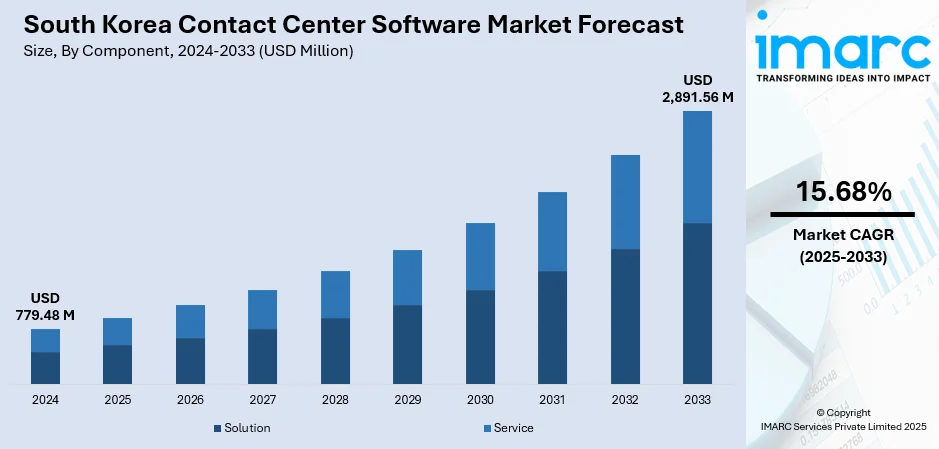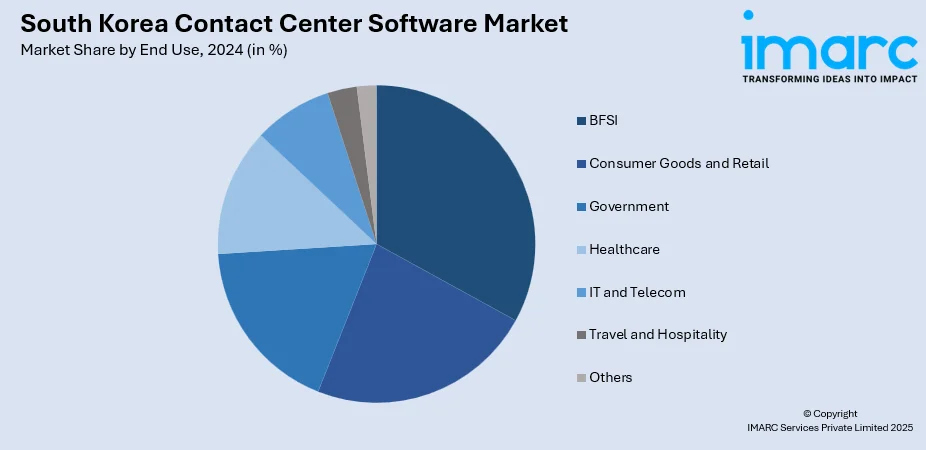
South Korea Contact Center Software Market Size, Share, Trends and Forecast by Component, Deployment Mode, Enterprise Size, End Use, and Region, 2025-2033
South Korea Contact Center Software Market Overview:
The South Korea contact center software market size reached USD 779.48 Million in 2024. Looking forward, the market is expected to reach USD 2,891.56 Million by 2033, exhibiting a growth rate (CAGR) of 15.68% during 2025-2033. The market is fueled by a shift toward cloud-hosted platforms, advanced analytics, and omnichannel customer engagement. Enterprises are adopting AI-powered tools like predictive routing and speech analytics to enhance service quality and operational efficiency. This transformation is reinforced by strong demand for scalable, secure, and integrated solutions. These dynamics collectively support the South Korea contact center software market share.
|
Report Attribute
|
Key Statistics
|
|---|---|
|
Base Year
|
2024
|
|
Forecast Years
|
2025-2033
|
|
Historical Years
|
2019-2024
|
| Market Size in 2024 | USD 779.48 Million |
| Market Forecast in 2033 | USD 2,891.56 Million |
| Market Growth Rate 2025-2033 | 15.68% |
South Korea Contact Center Software Market Trends:
Rapid Shift to Cloud-Based Solutions
One of the leading growth factors in South Korea is the adoption of cloud-based contact center software that is gaining popularity in the country. Flexible, scalable, and economic cloud platforms are going to replace the conventional on-premise systems in business. The solutions enable remote access, real-time updating, as well as integration of the tools with CRM tools and communication means such as voice, chat, email, and social media. This transformation is especially essential after the period of the pandemic, due to the increased popularity of such work formats as hybrid and remote working. Disaster recovery and business continuity are also improved with cloud contact center platforms. The small and medium enterprises (SMEs) are attracted to their pricing models based on subscriptions, which speeds up the availability of advanced customer service technology. As digital transformation accelerates across industries, cloud-hosted platforms are setting the foundation for modern, agile contact center operations.

To get more information on this market, Request Sample
Growing Demand for AI and Automation Technologies
South Korea’s highly connected and tech-savvy population has led to rising expectations for fast, personalized, and efficient customer service, which is boosting the South Korea contact center software market growth. To meet this demand, organizations are adopting AI-powered tools like chatbots, speech analytics, and predictive call routing. These technologies not only improve response times but also reduce operational costs by automating routine tasks and streamlining agent workflows. Integration of natural language processing (NLP) and machine learning allows systems to better understand customer intent, deliver context-aware responses, and analyze sentiment in real time. AI also helps forecast call volumes and optimize agent scheduling. As companies strive for higher customer satisfaction and efficiency, AI-enabled contact center software is becoming essential for delivering intelligent, data-driven support at scale.
Omnichannel Communication and Customer Experience Focus
The shift toward omnichannel communication is transforming the South Korea contact center software landscape. Consumers today expect seamless, consistent interactions across various platforms, whether it's phone, webchat, email, mobile apps, or social media. Businesses are investing in unified contact center solutions that consolidate these channels into a single interface, enabling agents to manage customer interactions efficiently. Enhanced visibility into customer histories and preferences allows for more personalized and proactive service. Additionally, real-time reporting, customer journey mapping, and feedback mechanisms are helping organizations continuously refine their customer experience strategies. This customer-centric approach is critical in competitive markets like South Korea, where brand loyalty and satisfaction are closely tied to the quality and consistency of service across all digital touchpoints.
South Korea Contact Center Software Market Segmentation:
IMARC Group provides an analysis of the key trends in each segment of the market, along with forecasts at the country and regional levels for 2025-2033. Our report has categorized the market based on component, deployment mode, enterprise size, and end use.
Component Insights:
- Solution
- Automatic Call Distribution (ACD)
- Call Recording
- Computer Telephony Integration (CTI)
- Customer Collaboration
- Dialer
- Interactive Voice Responses (IVR)
- Others
- Service
- Integration and Deployment
- Support and Maintenance
- Training and Consulting
- Managed Services
The report has provided a detailed breakup and analysis of the market based on the component. This includes solution (automatic call distribution (ACD), call recording, computer telephony integration (CTI), customer collaboration, dialer, interactive voice responses (IVR), and others) and service (integration and deployment, support and maintenance, training and consulting, and managed services).
Deployment Mode Insights:
- On-premises
- Cloud-based
A detailed breakup and analysis of the market based on the deployment mode have also been provided in the report. This includes on-premises and cloud-based.
Enterprise Size Insights:
- Large Enterprises
- Small and Medium-sized Enterprises
The report has provided a detailed breakup and analysis of the market based on the enterprise size. This includes large enterprises and small and medium-sized enterprises.
End Use Insights:

- BFSI
- Consumer Goods and Retail
- Government
- Healthcare
- IT and Telecom
- Travel and Hospitality
- Others
A detailed breakup and analysis of the market based on the end use have also been provided in the report. This includes BFSI, consumer goods and retail, government, healthcare, IT and telecom, travel and hospitality, and others.
Regional Insights:
- Seoul Capital Area
- Yeongnam (Southeastern Region)
- Honam (Southwestern Region)
- Hoseo (Central Region)
- Others
The report has also provided a comprehensive analysis of all the major regional markets, which include Seoul Capital Area, Yeongnam (Southeastern Region), Honam (Southwestern Region), Hoseo (Central Region), and others.
Competitive Landscape:
The market research report has also provided a comprehensive analysis of the competitive landscape. Competitive analysis such as market structure, key player positioning, top winning strategies, competitive dashboard, and company evaluation quadrant has been covered in the report. Also, detailed profiles of all major companies have been provided.
South Korea Contact Center Software Market News:
- In July 2025, ON24, a prominent platform specializing in intelligent engagement for B2B sales and marketing, formed a strategic alliance with Performars, a company recognized for its expertise in Revenue Operations (RevOps), CRM advisory services, and digital growth acceleration. This partnership supports ON24’s ongoing expansion into the rapidly growing markets of South Korea and Taiwan, helping local businesses boost revenue by capturing, converting, and scaling first-party digital customer interactions.
- In September 2024, Kore.ai, a leading provider of enterprise-grade conversational and generative AI platforms, made two of its flagship solutions, Kore.ai XO Automation and Kore.ai Contact Center AI, accessible through the AWS Marketplace. This specialized digital platform allows businesses to seamlessly explore, procure, implement, and oversee third-party software, data, and services that enhance solution development and streamline business processes.
South Korea Contact Center Software Market Report Coverage:
| Report Features | Details |
|---|---|
| Base Year of the Analysis | 2024 |
| Historical Period | 2019-2024 |
| Forecast Period | 2025-2033 |
| Units | Million USD |
| Scope of the Report |
Exploration of Historical Trends and Market Outlook, Industry Catalysts and Challenges, Segment-Wise Historical and Future Market Assessment:
|
| Components Covered |
|
| Deployment Modes Covered | On-premises, Cloud-based |
| Enterprise Sizes Covered | Large Enterprises, Small and Medium-sized Enterprises |
| End Uses Covered | BFSI, Consumer Goods and Retail, Government, Healthcare, IT and Telecom, Travel and Hospitality, Others |
| Regions Covered | Seoul Capital Area, Yeongnam (Southeastern Region), Honam (Southwestern Region), Hoseo (Central Region), Others |
| Customization Scope | 10% Free Customization |
| Post-Sale Analyst Support | 10-12 Weeks |
| Delivery Format | PDF and Excel through Email (We can also provide the editable version of the report in PPT/Word format on special request) |
Key Questions Answered in This Report:
- How has the South Korea contact center software market performed so far and how will it perform in the coming years?
- What is the breakup of the South Korea contact center software market on the basis of component?
- What is the breakup of the South Korea contact center software market on the basis of deployment mode?
- What is the breakup of the South Korea contact center software market on the basis of enterprise size?
- What is the breakup of the South Korea contact center software market on the basis of end use?
- What is the breakup of the South Korea contact center software market on the basis of region?
- What are the various stages in the value chain of the South Korea contact center software market?
- What are the key driving factors and challenges in the South Korea contact center software market?
- What is the structure of the South Korea contact center software market and who are the key players?
- What is the degree of competition in the South Korea contact center software market?
Key Benefits for Stakeholders:
- IMARC’s industry report offers a comprehensive quantitative analysis of various market segments, historical and current market trends, market forecasts, and dynamics of the South Korea contact center software market from 2019-2033.
- The research report provides the latest information on the market drivers, challenges, and opportunities in the South Korea contact center software market.
- Porter's five forces analysis assist stakeholders in assessing the impact of new entrants, competitive rivalry, supplier power, buyer power, and the threat of substitution. It helps stakeholders to analyze the level of competition within the South Korea contact center software industry and its attractiveness.
- Competitive landscape allows stakeholders to understand their competitive environment and provides an insight into the current positions of key players in the market.
Need more help?
- Speak to our experienced analysts for insights on the current market scenarios.
- Include additional segments and countries to customize the report as per your requirement.
- Gain an unparalleled competitive advantage in your domain by understanding how to utilize the report and positively impacting your operations and revenue.
- For further assistance, please connect with our analysts.
 Request Customization
Request Customization
 Speak to an Analyst
Speak to an Analyst
 Request Brochure
Request Brochure
 Inquire Before Buying
Inquire Before Buying




.webp)




.webp)












